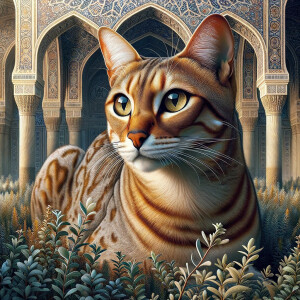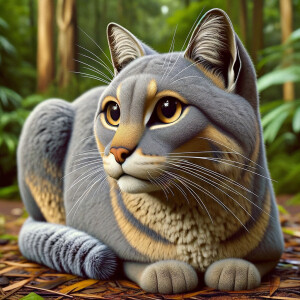Select animal and breed you want to learn more about
Cat Breeds Ultimate Guide
Cat Breeds Ultimate Guide
ABYSSINIAN
The Abyssinian cat is a popular and elegant breed known for its distinctive ticked coat, giving them a wild appearance reminiscent of a tiny jungle cat. These affectionate and lively cats are intelligent, curious, and playful companions, always eager to explore and engage with their human families. With their striking almond shaped eyes and expressive faces, Abyssinians are beloved for their beauty and boundless energy, making them a cherished addition to any loving home.
The Abyssinian cat is a popular and elegant breed known for its distinctive ticked coat, giving them a wild appearance reminiscent of a tiny jungle cat. These affectionate and lively cats are intelligent, curious, and playful companions, always eager to explore and engage with their human families. With their striking almond shaped eyes and expressive faces, Abyssinians are beloved for their beauty and boundless energy, making them a cherished addition to any loving home.
ALL
The cat breed 'all' is a diverse and inclusive category encompassing a wide range of feline characteristics, including various coat lengths, colors, patterns, and personalities. Cats of the 'all' breed are known for their adaptability, intelligence, and affectionate nature, making them popular choices as pets for households of all kinds. With such a broad spectrum of traits and qualities, the 'all' breed is as unique and individual as each cat within it, offering something for everyone to love and appreciate.
The cat breed 'all' is a diverse and inclusive category encompassing a wide range of feline characteristics, including various coat lengths, colors, patterns, and personalities. Cats of the 'all' breed are known for their adaptability, intelligence, and affectionate nature, making them popular choices as pets for households of all kinds. With such a broad spectrum of traits and qualities, the 'all' breed is as unique and individual as each cat within it, offering something for everyone to love and appreciate.
AMERICAN BOBTAIL
The American Bobtail is a unique and charming cat breed known for its distinctive bobbed tail, which can be either short or long. These cats are intelligent, affectionate, and adaptable, making them great companions for families and individuals. With their playful and social nature, American Bobtails are good with children and other pets, forming strong bonds with their human companions. This breed's striking appearance, with a wild appearance reminiscent of a bobcat, coupled with their friendly personality, makes the American Bobtail a popular choice among cat lovers.
The American Bobtail is a unique and charming cat breed known for its distinctive bobbed tail, which can be either short or long. These cats are intelligent, affectionate, and adaptable, making them great companions for families and individuals. With their playful and social nature, American Bobtails are good with children and other pets, forming strong bonds with their human companions. This breed's striking appearance, with a wild appearance reminiscent of a bobcat, coupled with their friendly personality, makes the American Bobtail a popular choice among cat lovers.
AMERICAN CURL
The American Curl is a unique and elegant breed known for its distinctive curled back ears that give it a charmingly friendly and alert expression. This medium sized cat is prized for its playful and affectionate nature, making it an ideal companion for families and individuals alike. With a silky coat that comes in a variety of colors and patterns, the American Curl's most striking feature is its curled ears, which begin to develop at around 16 days old. Overall, the American Curl is a delightful and loving breed that brings joy and warmth to any home.
The American Curl is a unique and elegant breed known for its distinctive curled back ears that give it a charmingly friendly and alert expression. This medium sized cat is prized for its playful and affectionate nature, making it an ideal companion for families and individuals alike. With a silky coat that comes in a variety of colors and patterns, the American Curl's most striking feature is its curled ears, which begin to develop at around 16 days old. Overall, the American Curl is a delightful and loving breed that brings joy and warmth to any home.
AMERICAN SHORTHAIR
The American Shorthair cat breed is known for its versatility, adaptability, and affectionate nature. With a medium to large build, rounded ears, and expressive eyes, American Shorthairs come in a wide variety of coat colors and patterns. Recognized for their playful and sociable demeanor, they make excellent companions for individuals and families alike. This breed is easy to groom, generally healthy, and known for its long lifespan, making them a popular choice for those seeking a loving and low maintenance feline friend.
The American Shorthair cat breed is known for its versatility, adaptability, and affectionate nature. With a medium to large build, rounded ears, and expressive eyes, American Shorthairs come in a wide variety of coat colors and patterns. Recognized for their playful and sociable demeanor, they make excellent companions for individuals and families alike. This breed is easy to groom, generally healthy, and known for its long lifespan, making them a popular choice for those seeking a loving and low maintenance feline friend.
AMERICAN WIREHAIR
The American Wirehair is a unique and charming breed known for its distinct wiry coat that is both dense and crimped. With a friendly and affectionate demeanor, American Wirehairs make excellent companions for families and individuals alike. These cats are adaptable and easygoing, enjoying both playtime and lounging with their human companions. Their robust health and low maintenance coat make them a popular choice for cat lovers seeking a special feline friend with a one of a kind appearance.
The American Wirehair is a unique and charming breed known for its distinct wiry coat that is both dense and crimped. With a friendly and affectionate demeanor, American Wirehairs make excellent companions for families and individuals alike. These cats are adaptable and easygoing, enjoying both playtime and lounging with their human companions. Their robust health and low maintenance coat make them a popular choice for cat lovers seeking a special feline friend with a one of a kind appearance.
APPLEHEAD SIAMESE
The applehead Siamese cat is a beloved breed known for its striking appearance, characterized by a sleek, slender body, striking blue almond-shaped eyes, and distinctive "apple" shaped head. Renowned for their affectionate and social nature, applehead Siamese cats are intelligent, vocal, and thrive on human companionship. Their short coat is typically seal point, chocolate point, blue point, or lilac point in coloration. With their playful and outgoing personalities, applehead Siamese cats make wonderful companions for those seeking a lively and interactive feline friend.
The applehead Siamese cat is a beloved breed known for its striking appearance, characterized by a sleek, slender body, striking blue almond-shaped eyes, and distinctive "apple" shaped head. Renowned for their affectionate and social nature, applehead Siamese cats are intelligent, vocal, and thrive on human companionship. Their short coat is typically seal point, chocolate point, blue point, or lilac point in coloration. With their playful and outgoing personalities, applehead Siamese cats make wonderful companions for those seeking a lively and interactive feline friend.
ARABIAN MAU
The Arabian Mau is a elegant and sleek cat breed known for its striking appearance and friendly nature. This ancient breed hails from the Arabian Peninsula and is highly prized for its agility, intelligence, and gentle demeanor. Arabian Maus have a distinctive coat pattern with beautiful spots and shimmering hues that make them stand out. They are known to be excellent companions, forming strong bonds with their owners and adapting well to various living environments.
The Arabian Mau is a elegant and sleek cat breed known for its striking appearance and friendly nature. This ancient breed hails from the Arabian Peninsula and is highly prized for its agility, intelligence, and gentle demeanor. Arabian Maus have a distinctive coat pattern with beautiful spots and shimmering hues that make them stand out. They are known to be excellent companions, forming strong bonds with their owners and adapting well to various living environments.
ASIAN
The Asian cat breed, known for its elegant appearance and playful demeanor, is a loving and social feline that thrives on human interaction. With sleek bodies and striking almond shaped eyes, Asians resemble the Siamese and Burmese breeds. They are intelligent and adept at learning tricks, making them a joy to train. Asian cats enjoy climbing and exploring their surroundings, showing off their curious and adventurous nature. With their affectionate disposition, they make wonderful companions for families and individuals alike.
The Asian cat breed, known for its elegant appearance and playful demeanor, is a loving and social feline that thrives on human interaction. With sleek bodies and striking almond shaped eyes, Asians resemble the Siamese and Burmese breeds. They are intelligent and adept at learning tricks, making them a joy to train. Asian cats enjoy climbing and exploring their surroundings, showing off their curious and adventurous nature. With their affectionate disposition, they make wonderful companions for families and individuals alike.
ASIAN SEMI LONGHAIR
The Asian Semi Longhair is a charming and affectionate cat breed with a semi long coat in a variety of colors and patterns. Known for its playful and loving nature, this breed is intelligent and enjoys interactive play with its human companions. Originating from Asia, these elegant cats have striking almond shaped eyes and a medium sized body with a lush tail. The Asian Semi Longhair makes a wonderful addition to any household and thrives in a loving and engaging environment.
The Asian Semi Longhair is a charming and affectionate cat breed with a semi long coat in a variety of colors and patterns. Known for its playful and loving nature, this breed is intelligent and enjoys interactive play with its human companions. Originating from Asia, these elegant cats have striking almond shaped eyes and a medium sized body with a lush tail. The Asian Semi Longhair makes a wonderful addition to any household and thrives in a loving and engaging environment.
AUSTRALIAN MIST
The Australian Mist cat breed, known for its friendly and affectionate nature, originated in Australia in the late 1970s. These playful and energetic cats have a unique coat pattern of marbled or spotted markings in warm colors like brown, blue, and gold. Australian Mists are adaptable to various living environments, making them suitable for both apartments and houses. With their social and gentle temperament, they make excellent companions for families and individuals alike.
The Australian Mist cat breed, known for its friendly and affectionate nature, originated in Australia in the late 1970s. These playful and energetic cats have a unique coat pattern of marbled or spotted markings in warm colors like brown, blue, and gold. Australian Mists are adaptable to various living environments, making them suitable for both apartments and houses. With their social and gentle temperament, they make excellent companions for families and individuals alike.
BALINESE
The Balinese is a breed of domestic cat known for its stunning appearance and affectionate personality. Often described as having a Siamese body with a semi long haired coat, the Balinese is elegant and graceful. Their silky fur comes in various pointed colors, accentuating their striking blue almond shaped eyes. Intelligent and social, Balinese cats thrive on human companionship and enjoy interactive play. With their outgoing nature and vocal tendencies, these charming felines make wonderful additions to loving homes.
The Balinese is a breed of domestic cat known for its stunning appearance and affectionate personality. Often described as having a Siamese body with a semi long haired coat, the Balinese is elegant and graceful. Their silky fur comes in various pointed colors, accentuating their striking blue almond shaped eyes. Intelligent and social, Balinese cats thrive on human companionship and enjoy interactive play. With their outgoing nature and vocal tendencies, these charming felines make wonderful additions to loving homes.












